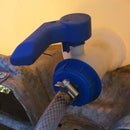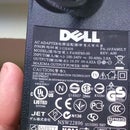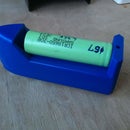Introduction: Build a Huge 7 Segments 8 Digits Red LED Display
This instructables presents how to make a huge 7 segments 8 digits LED display panel. The purpose of this display is to display the time, date, temperature or to be used as a chronometer at various running contests, mountain bike contests, trail running contests and so on (organized by NGOs with low budget). The display may show elapsed time (hours, minutes, seconds and hundreds of a second). In order to use the display, a microcontroller or digital interface is needed and this is above the scope of the current instructable.
The display may work as a stand alone device driven by a microcontroller (Arduino stuff) or may be driven by a PC / laptop (interfaced by some discrete digital logic).
Design constrains / requests:
-to be big enough to be readable from 20-30 meters
-to be bright enough to be visible / readable in sun light
-to use energy efficient light emitting devices (bulbs, LEDs) / (low electrical power consumption)
-to use feasible and long lasting light emitting devices
-to withstand to harsh environment (some contests may be during fall, winter times, during rain, strong sun)
-to be light and sturdy in the same time (it has to be carried from point A to B)
-to have a reasonable size in order to fit on regular vans or on the roof of a car - it must be carried from a location to another
-to show hours, minutes, seconds and miliseconds (hundreds of a second) as a chronometer
-to show as well the temperature (negative and positive), local time and current date
-to separate the pair of digits by ":" - 2 separation dots
-to allow multiplexing of segments and digits and separate control of minus and separation points
-to have a reasonable cost
-to involve a reasonable amount of work
-to look nice
Based on these requirements, my choice was to use red LED strips for 12Vdc (these are comming in reels and you can cut the desired length), polycarbonate panels and a wooden frame. All the LEDs were connected using cheap network cable (8 wires inside, full copper).
The LEDs were connected to form 7 segments per digit and 8 digits (6 digits are big size and 2 digits are small size (these 2 digits are used to display hundreds of a second)). Also in front of the first digit is a big minus sign (for negative temperatures) and between each pair of digits are 2 separation dots.
Tools needed:
-cutter
-scissor
-wire cutter (wire desoldering tool is nice to have)
-soldering iron and related tools for electronic parts soldering
-drilling machine and drill bits
-wood saw (any, you need to cut wood a few times)
-brush to paint
-silicone pistol
-hot glue pistol
-printer to print A4 sheets
-others (?!)
Materials needed:
-red LEDs - 2 reels at 12Vdc with adhesive back tape, one reel is 5 meters or 300 red LEDs (update 2014: you can look for LED reels with 120 LEDs per meter, the result is improved, see here another nice project: Giant Two-Digit Countdown Clock)
-polycarbonate panels for constructions - roofs (transparent preferred - mine was on sale and it is light brown)
-wood to build the wooden frame
-wood paint
-network cable 20 meters (UTP cable)
-sanitary silicone 2 tubes
-hot glue sticks 4-5 sticks
-thick paper pattern to align the segments and the digits - 6-8 A4 sheets (2 types - small and big)
-transparent packing tape
-plastic crosses for ceramic tiles 100 pieces pack should be more then enough (the thickness matter, so 3-4mm is ok or use 2, each one on top of the other)
-others (?!)
Unfortunately at the moment of building this huge 7 segments 8 digits LED display I didn't take too many pictures, I had no intention to share that experiment, but now I realized that it may be interesting for others as well.
Due to this reason, the instructable did not documented with pictures each detail, some of the existing pictures are not the best or the most explicit, so you need to understand my English or to imagine another way of performing the same operation. Or simply to ask where you don't understand :) !
Let's start!
2012/12/10 Edit: LED stripes -> LED strips - see comments for more explanations
Step 1: Creating the 7 Digits Display Paper Pattern
In order to determine the size of the 7 segments digits, I took into consideration the LEDs first.
The LEDs are coming in reels and are powered by 12Vdc. I can cut the desired length of LED stripe, but I had to follow a few rules:
-minimum LED stripe consist of 3 LEDs, this is 5 cm (~2 inches) minimum length
-the LED segment must be multiple of 5 cm
-each LED segment must have 2 power wires at one end (+12Vdc and GND)
-LED segments of a 7 segment digit have a specific angle - see a small 7 segments LED display to understand what I'm talking about
-LED digits have a certain clearance between them
-the points between each pair of digits must be made from 2 small strips in parallel (5cm strips)
So here are the choices: the big 7 segments display used 3 LED strips of 5cm LED (3 LEDs per stripe), the small one uses 2 LED strips x 5cm.
In order to make the 7 segments digit paper pattern, I downloaded from the internet a 7 segment display image and I scale it up in order to fit the 15cm and 10cm LED segment size lengths. Since I used 2 types of digits (small and big), 2 sizes of paper pattern were created.
In the end, the big digit is 33cm tall by 22cm wide and the small digit is 23cm tall by 16cm wide.
The paper used was A4 size, 4 sheets put together using packing tape; these were printed at home using my personal printer. After that, some cuts/holes were cut at each end of each segment on the paper patterns in order to be able to mark the points where to fit the LED strips - assembly guides.
Step 2: Trimming the Polycarbonate and Marking the LED Segment's Positions
Based on the size of the 7 digits display and based on the distance between the displays, the polycarbonate panel was trimmed. The polycarbonate sheet was 2 meters long and 1 meter wide.
The operation was performed using the cutter, I cut 2 identical pieces, 50cm by 200cm. Beware which side is the face you want to use for inside and for outside. Peel the protective sheet from the polycarbonate panel now on the part used as inside.
I used the paper pattern to mark the points on one piece I cut before - put the pattern on the polycarbonate sheet and mark the points using a permanent marker (like Sharpie or similar).
I double checked that I marked correctly and things are looking like a pattern for a huge 7 segments LED display - 8 displays.
Step 3: LED Strips Creation
Next step was to take the LED reel and to cut the strips at the length I needed. This was completed using the scissor. At the mark on the LED stripe, I cut the length.
For a big LED segment I cut at every 15 cm (3 groups of 3 LEDs or 3 lengths of 5cm), for the small segment, I cut at every 10 cm (2 groups of 3 LEDs or 2 lengths of 5cm).
The big minus sign I cut it from 3 groups and the small points between each pair of 7 segments display I cut from 2 x 3cm LED stripe.
Step 4: Soldering the Power Wires to Each LED Stripe
I bought 20 meters of network cable with full copper wire inside. I stripped the gray insulation out of the cable and the 4 pairs of wires were accessible. I used a drilling machine to untwist each pair of wire (cut 5-6 meters once and untwist them) (like this guys did it on this clip: http://www.youtube.com/watch?v=hFX660cIa0o), in this way I obtained a lot of wires, 8 different colors.
I cut equal wire lengths and I stripped the ends of each wire length to prepare them for soldering.
For each LED stripe I cut in the previous step, 2 wires were soldered: +12Vdc and GND. The LED separation points (the ones between each pair of digits) were soldered in a little bit different way since were needed 2 x 5cm strips in parallel. After that step,
I had a lot of LED strips wired at one end (but no pictures taken at that moment, sorry).
Step 5: LED Strips Assembly on the Polycarbonate Panel
The LED stripe has a nice feature: on the back of it, is adhesive tape. Just remove the paper tape and the LED stripe can be glued on a surface in a very convenient way. On my LEDs it was visible the 3M logo, I assumed it is a quality adhesive.
In the previous steps I marked the polycarbonate panel to know where to glue the strips, so I glued all the strips on the polycarbonate panel according to the markings previously done.
Step 6: LED Segments Wiring and Soldering
Since I have 7 LED segments on each digit and 8 LED digits, since I have 3 pairs of LED separation dots and a minus sign, a color scheme was needed. Also, for future use, each segment, digit, each pair of separation dots and the minus sign must be controlled separated (by multiplexing them of course). I considered that I have to create 3 wire buses:
-a segment bus - 7 lines for segments
-a digit bus - 8 lines for digits
-a separation dots . minus sign bus - 2 lines for the minus sign and 6 lines for the separation points
-----------total 23 lines in 3 buses
That means to use 3 network cables (each one has 8 wires, 3 x 8 = 24 wires). I took 3 meters of cable and I stripped the network cable grey insulation on about 2 meters of the total length, I kept some insulation on the end which goes outside the polycarbonate panel. Using hot glue, the bus was assembled on the polycarbonate panel. I created this color schematic in order to make an easy assembly of the LED segments to the bus (soldering the wires).
Step 7: LED Strips Wiring to the Bus
Following the color schematic, on each bus wire I removed the insulation on 3 mm at the point where the LED wire came in contact with the bus wire. I soldered the LED stripe wire to the bus wire. I did this for all the LED strips and each bus line (7 segments X 2 wires X 8 displays = 112 solder joints).
After each solder joint, I checked if the LED was turning on and if the current was similar like for a reference LED stripe (to make sure that the solder joint is well done - avoid cold solder joints). (at this step I took no picture at that moment, sorry)
Step 8: Hot Glueing the Wires and the Ceramic Tile Spacers on the Polycarbonate Panels
Since there are so many wires and some are not insulated (remember, I removed some insulation in order to solder them), all these can put some mechanical tension on the LED strips and can force them to bend and not to stay on the polycarbonate panel. That is why I used hot glue (hot melt) for the wires, to make them to sit in the proper position, also to insulated some of them.
The plastic spacers for ceramic tiles are used to ensure some clearance between the 2 polycarbonate panels - in the end it is like a sandwich: polycarbonate on sides and LEDs in the middle. I don't want that the top polycarbonate panel to touch the LEDs. This was done using hot glue and for each point 2 spacers were glued one on top of the other.
I checked one more time that the LED strips can lit using the bus wires. It is important to check this because on the next step I put the other polycarbonate panel on top of the LEDs and I sealed the assembly. (again, no images for this step)
Step 9: Sealing the Polycarbonate Sandwich
Using sanitary silicone and the silicone pistol / gun, I draw a contour on the LED polycarbonate panel. I made sure that the thickness or the sealant is thick enough to seal completely when the other panel is put on top of the sandwich.
The silicone excess was removed and spread on the sides of the sandwich. A secondary sealing contour was applied on the exterior and was spread as well on the entire edge of the panels.
If you look from the side, the polycarbonate panel has its profile like small pipes, I recommend to seal them, if water gets in, may affect the transparency. Leave the silicone to cure for about 24 hours. After that, I cut the corners of the panels at 45 degrees.
Step 10: Making the Wooden Frame
After the polycarbonate sandwich was assembled and sealed, I measured the size of it and I designed the wooden frame and I asked someone to build it for me. I am pretty sure that there are some other ideas to make that frame ( from aluminum, PVC and so on). After I got the wooden frame, I drilled the holes to take the cables out. After that, I painted the wooden frame in 2 layers, to make sure that it will last longer.
The wooden frame is 206,5cm by 55cm and has an "L" profile in order to fit the polycarbonate sandwich. Also I put a threaded metal rod M4 on the middle of the frame in order to make it sturdy (wood is elastic and the sandwich may fall out of the wooden frame).
There you can see the protection foil on the polycarbonate sheet, that part is on the back of the display and is not directly visible. I tried to peel it off, I cleaned the front face visible to the audience, but was hard and in the end I gave up on the other face.
Step 11: Assembling the Polycarbonate Panels and the Wooden Frame
This is pretty straight forward, I used some metal "L" shape pieces and some small wood screws. The metal "L"-s were bended with the help of a hammer and a vice - see images for details. These parts hold the polycarbonate panels close to the wooden frame.
Also I used some hooks and some small carabiners in order to have some hanging points (the display has to be hanged on a higher point for visibility).
Here is the final result of the huge 7 segments 8 digits LED display panel:
Some facts:
-Total number of red LEDs: 525 pieces
-8 digits, 7 segments red LED
-Total length of LED stripe: 875 cm (one reel of 5 meters + 3,75 meters from a secondary reel)
-Total current when all LEDs are on (at 12Vdc): ~2 amps
-Size of the finished LED panel display: L 206,5cm x h 55cm x t 6cm
-Weight of the finished LED panel display: 9 kg
Step 12: About Using the Display - Electronic Schematic
Update Feb 2015
At the time when I published this, I did not have a schematic ready for it. During the time people asked me about how this can be used. I think that the Internet is full of examples of microcontrollers using 7 segments digits, so this should not be a problem.
What can be a problem is the fact that my display is powered at 12Vdc while the microcontroller is at 3,3 or 5 Vdc. Therefore there is a need to create some interface between the 12Vdc display and the 3,3 - 5 Vdc microcontroller.
In order to multiplex the segments and the digits, it must be controlled each digit and each segment, to you need to control the positive and the negative (ground) of the 12Vdc power supply.
Here is the schematic I put together, this must be extended to all digits and for each segment as follows:
-T1 / Q1 part must be extended to all 8 digits since the display is with common anode
-Q2 part must be extended to all 7 segments since the display uses 7 segments digits and the cathode is separated (this is how we control each digit)
-the dots and minus can be controlled what ever we want (I recommend connecting directly the anode to +12Vdc and use the Q2 part of the schematic (less parts))













